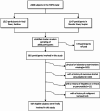Triglyceride-glucose index is independently associated with fatty pancreas disease in Chinese elderly
- PMID: 40102915
- PMCID: PMC11916974
- DOI: 10.1186/s12902-025-01900-9
Triglyceride-glucose index is independently associated with fatty pancreas disease in Chinese elderly
Abstract
Objective: To determine the prevalence of fatty pancreas disease (FPD) diagnosed by transabdominal ultrasound in Chinese elderly aged 65 years and above to explore the correlation between triglyceride glucose index (TyG index) and FPD and its severity, and to evaluate the ability of TyG index to identify FPD and its severity.
Methods: The study population was derived from the Thyroid Diseases in Older Population: Screening, Surveillance, and Intervention (TOPS) study conducted in the iodine-adapted areas of Jiangsu Province from May to July 2021. A total of 567 participants aged 65 years and above in rural areas were included in the final analysis. TyG index was calculated by the established formula: Ln [TG (mg/dL) × FBG (mg/dL)/2]. FPD and the degree of intra-pancreatic fat deposition (IPFD) were diagnosed by abdominal ultrasound. The logistic regression model was performed to determine the correlation between clinical parameters, including TyG index, and FPD and its severity. The diagnostic power of TyG index was assessed by receiver operating characteristic curve (ROC).
Results: Overall, 72.66% (412/567) of subjects had FPD, of which over half had moderate to severe FPD. The proportions of overweight, obesity, NAFLD, and dyslipidemia were significantly higher in the moderate-to-severe FPD group than in the mild FPD group. Multivariate logistic regression showed that TyG index was independently associated with FPD in the elderly population, but was not significantly associated with the severity of IPFD. As the level of TyG index increased, the metabolic disorders in the population worsened and the prevalence of FPD increased significantly. TyG index had a good diagnostic performance for FPD. The combination of BMI or NAFLD and TyG index improved the diagnostic ability for FPD.
Conclusion: The prevalence of FPD diagnosed by abdominal ultrasound is high in the elderly aged 65 years and above in rural areas in China. TyG index has good identification of FPD but poor recognition of the severity of IPFD. TyG index, when combined with other clinical parameters, may have more diagnostic advantages.
Keywords: Elderly; Fatty pancreas disease; Triglyceride-glucose index.
© 2025. The Author(s).
Conflict of interest statement
Declarations. Ethics approval and consent to participate: The study was conducted in accordance with the Declaration of Helsinki and approved by the Ethics Committee of Affiliated Hospital of Integrated Traditional Chinese and Western Medicine, Nanjing University of Chinese Medicine (2023-LWKYZ-027). Written informed consent was obtained from parents of the participants. Consent for publication: Not applicable. Clinical trial number: Not applicable. Competing interests: The authors declare no competing interests.
Figures


Similar articles
-
Association between the triglyceride-glucose index and its combined obesity indicators and the risk of hypertension in middle-aged and older Chinese adults: A nationwide cross-sectional study.PLoS One. 2025 Jan 2;20(1):e0316581. doi: 10.1371/journal.pone.0316581. eCollection 2025. PLoS One. 2025. PMID: 39746074 Free PMC article.
-
Association between triglyceride glucose-body mass index and non-alcoholic fatty liver disease in the non-obese Chinese population with normal blood lipid levels: a secondary analysis based on a prospective cohort study.Lipids Health Dis. 2020 Oct 28;19(1):229. doi: 10.1186/s12944-020-01409-1. Lipids Health Dis. 2020. PMID: 33109219 Free PMC article.
-
The association between triglyceride-glucose index combined with obesity indicators and stroke risk: A longitudinal study based on CHARLS data.BMC Endocr Disord. 2024 Nov 1;24(1):234. doi: 10.1186/s12902-024-01729-8. BMC Endocr Disord. 2024. PMID: 39487484 Free PMC article.
-
Predicting metabolic syndrome by obesity- and lipid-related indices in mid-aged and elderly Chinese: a population-based cross-sectional study.Front Endocrinol (Lausanne). 2023 Jul 28;14:1201132. doi: 10.3389/fendo.2023.1201132. eCollection 2023. Front Endocrinol (Lausanne). 2023. PMID: 37576971 Free PMC article.
-
Comparison of triglyceride glucose index and modified triglyceride glucose indices in prediction of cardiovascular diseases in middle aged and older Chinese adults.Cardiovasc Diabetol. 2024 May 29;23(1):185. doi: 10.1186/s12933-024-02278-z. Cardiovasc Diabetol. 2024. PMID: 38812015 Free PMC article.
Cited by
-
Association between triglyceride-glucose index and subclinical carotid atherosclerosis in systemic lupus erythematosus: a cohort-based study.Front Immunol. 2025 Jun 25;16:1614970. doi: 10.3389/fimmu.2025.1614970. eCollection 2025. Front Immunol. 2025. PMID: 40636109 Free PMC article.
References
MeSH terms
Substances
Supplementary concepts
Grants and funding
- S202017, S202110/Suqian Key Research and Development Program
- LK2021059/Geriatric Health Scientific Research Project of Jiangsu Province
- M2020102/Medical Scientific Research Foundation of Jiangsu Province of China (Surface project)
- JD2022SZXZD05, JD2023SZX08/Open project of the National Traditional Chinese Medicine Clinical Research Base
LinkOut - more resources
Full Text Sources
Medical
Research Materials
Miscellaneous

